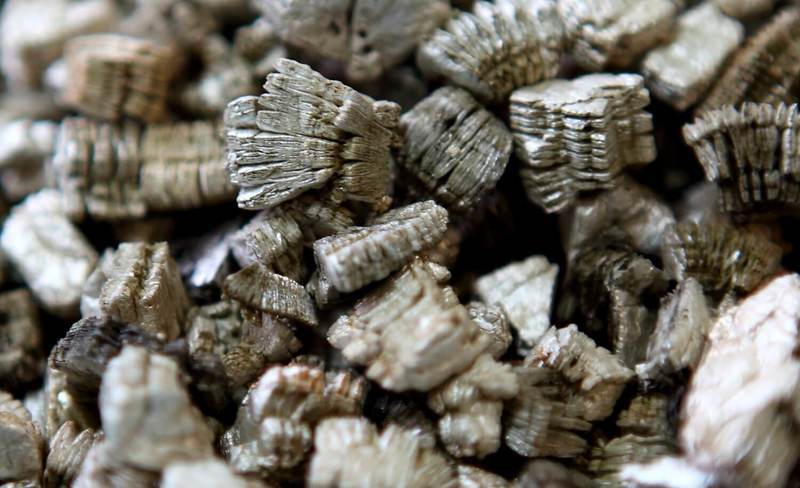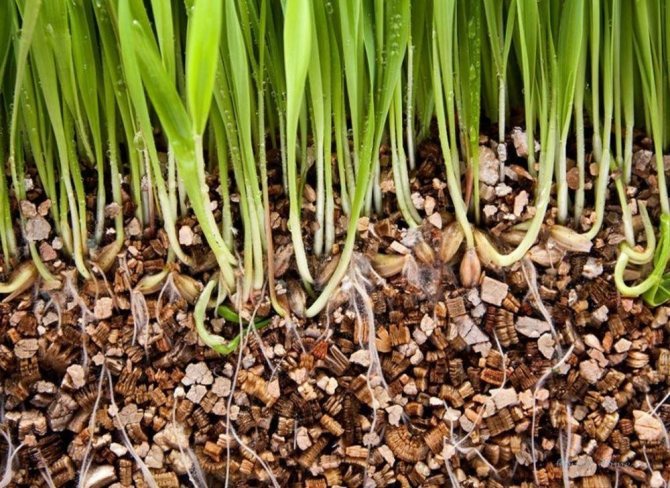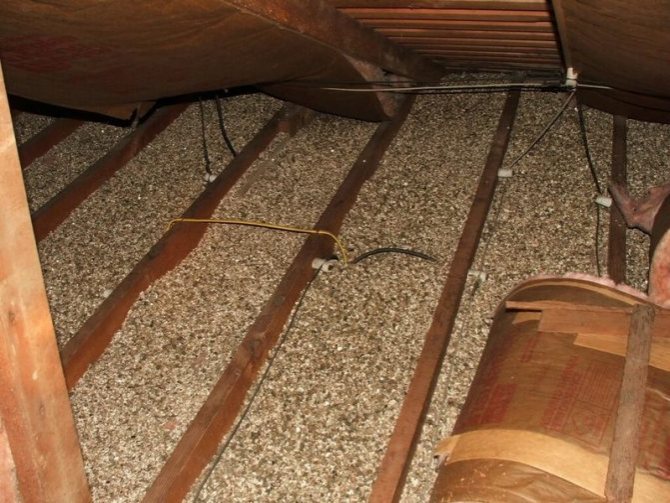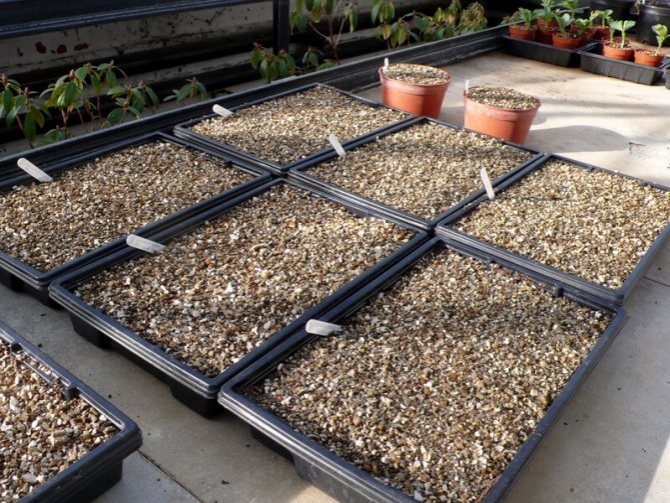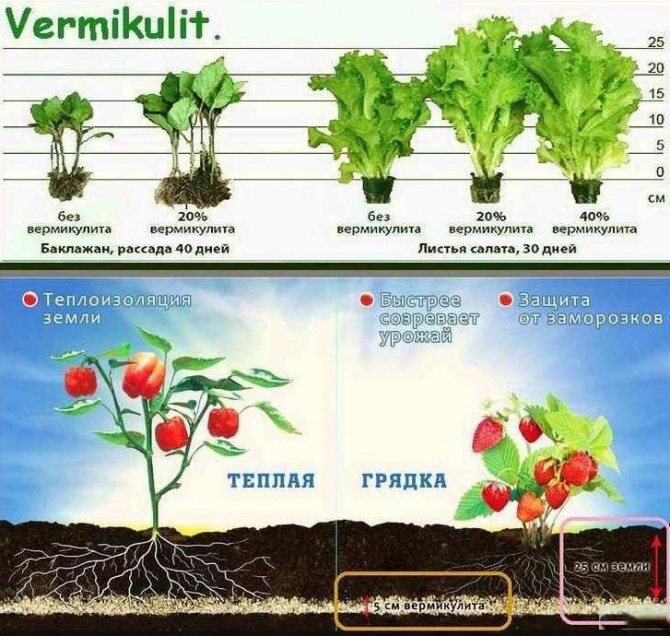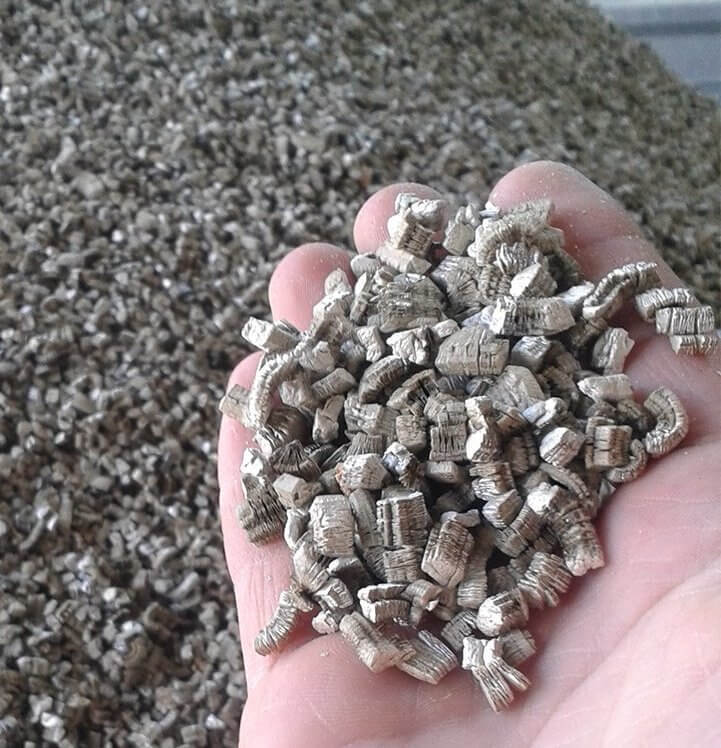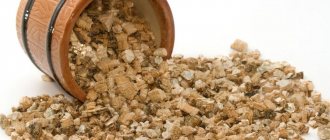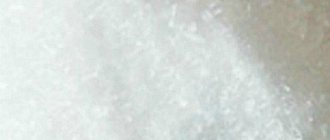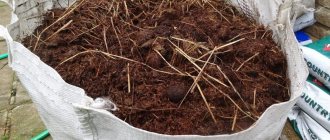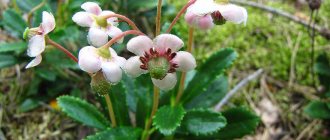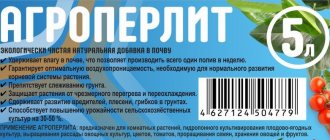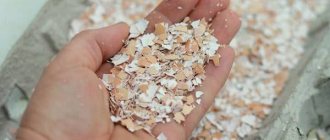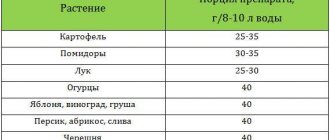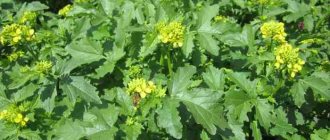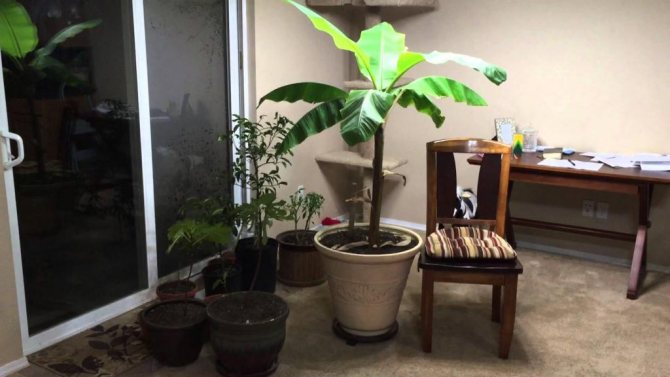
- 13 October, 2018
- Increased fertility
- Vasily Shushakov
Experienced gardeners know that proper care is essential to achieve the desired results in growing plants. In order to increase productivity, various fertilizers and additives are used, including vermiculite. What is this mineral and what is its need? A good question that should not be overlooked.
General information about the mineral
Vermiculite is a free-flowing material in the form of plates of a golden brown or silver hue, which is as similar as possible to hydromica, and in fact, it is. The term itself comes from the Latin vermiculus, which means "worm" in Russian.
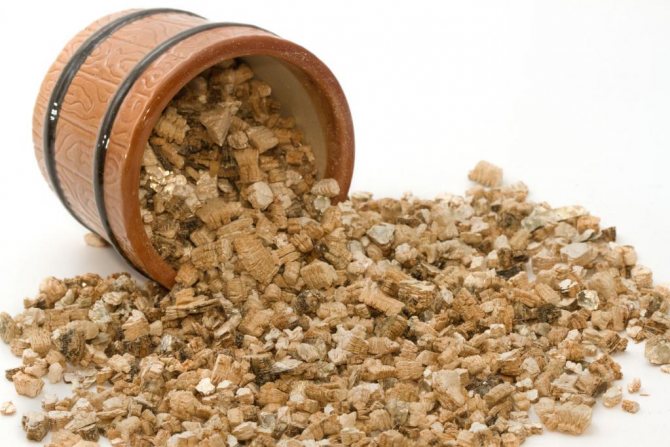

If vermiculite is exposed to high temperatures, its plates will take the form of thread-like granules, which outwardly resembles small worms. Due to the porous structure, the material is able to absorb and retain moisture, the volume of which can be 4 times its own weight. In other words, it acts like a good sponge.
This quality makes vermiculite an irreplaceable addition to earth mixes. At the same time, soil moisture remains for quite a long time, as well as nutrients.
What is Vermiculite and Agrovermiculite
Vermiculite is a resinous mineral found in nature, it is classified as a hydromica group. The color is represented by plates of yellow-brown, brown or black colors. It is formed subsequently by hydrolysis and weathering of dark mica.
In regions with high volcanic activity, vermiculite deposits warm up to 900-1000 ° C. As a result, excess moisture evaporates. The mineral increases by about 6-15 times, while the plates exfoliate, becoming light gold-colored scales - this is expanded vermiculite, also called agrovermiculite. It is able to absorb large amounts of moisture.
Vermiculite: is it an urgent need or a waste of time and energy?
Every gardener knows very well that the full development of plants depends on the quality of the soil. In the course of the growth of a horticultural culture, the soil undergoes certain changes, and not for the better. The soil cakes over time, becoming solid, water and air permeability decrease, as well as the amount of micronutrients.
An increase in irrigation ends with waterlogging and oversaturation of the soil, and the introduction of additional mineral fertilizers often turns into an overabundance of a number of components. Ultimately, this leads not only to a deterioration in plant development, but also to the appearance of unwanted diseases. The introduction of vermiculite into the soil avoids such problems.


We got acquainted with the benefits of this mineral, but how to use vermiculite for plants? After all, every gardener wants to grow only healthy and strong seedlings. This will be discussed further.
The whole truth about vermiculite for seedlings, research results
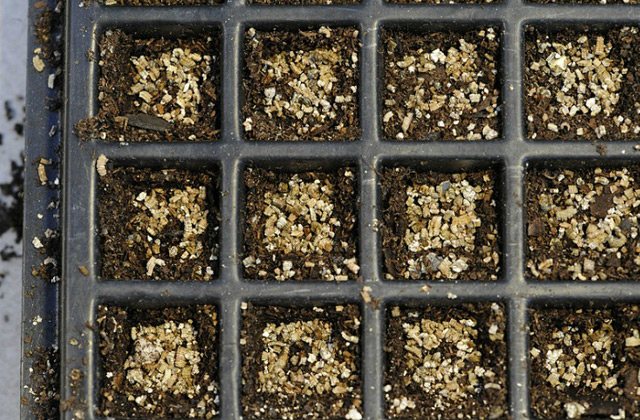

Much has been said about the effectiveness of the use of vermiculite for plants, but until recently, the mechanism of influence on seedlings has been insufficiently studied. In addition, you need to know the dosage for each crop group. Not everyone will want to experiment and spend money on the substrate, not being sure of a positive outcome.
Russian scientists Ismagilov R.R., Doctor of Agricultural Sciences, Akhiyarov B.G., Candidate of Agricultural Sciences, and Rakhimov R.R., an agronomist, have experimentally established the advantages of using vermiculite for seedlings of cucumber, tomato, cabbage and pepper. The germination rate, germination rate, plant height, and number of leaves were taken into account. For accuracy, the average value of four experiments is taken to exclude fluctuations in indicators.
What are the seedlings for?
Many vegetables are grown in seedlings. This is done to accelerate growth and harvest faster. In addition, the growing season is shortened, and the volume of vegetable production increases. Some vegetables cannot be grown in any other way, since there will not be enough period when the optimum air temperature and the length of daylight hours are established. Do not forget about saving seeds. The planting rate for growing vegetables directly in the open field is higher.
About 25% of the total cost of production falls on the costs associated with obtaining seedlings. But everything quickly pays off, since the early harvest of tomatoes and cucumbers is sold at an increased price.
The sowing time of the seeds is calculated in such a way that the seedlings are ready for planting in open ground in a timely manner. The main parameters that affect the quality of the planting material are air temperature and illumination. It is wise to use heated film greenhouses. Its construction is cheaper than a greenhouse, and the resulting plants tolerate changing conditions more easily and take root well. For seedlings, nutritious soil mixtures are prepared, fertilizers are applied. The soil should absorb water well, but at the same time remain light so that air can easily penetrate into the depths.
What is vermiculite?
Vermiculite is a natural mineral that is naturally formed from micas. Colored in colors ranging from silver, yellowish to red and brown. The color depends on which chemical elements prevail in the structure.
This substance is built up by large lamellar crystals that were formed in the process of hydrolysis and subsequent weathering of the dark micas of phlogipite and biotite.
Vermiculite granules have a scaly structure. When heated abruptly to 1000ºC, all water, including those associated with exchangeable ions, evaporates. The granules swell and grow 10 times. Many open pores appear, the suction surface increases, which makes vermiculite effective for retaining water in the soil. 1 m3 of such a substrate weighs only about 100 kg. The proportions of vermiculite and soil should provide plants with the optimal amount of water, but without excessive application of it.
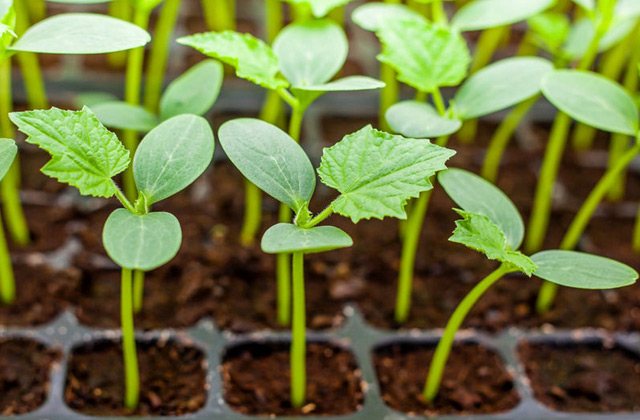

Vermiculite properties that improve soil structure:
- Air permeability. The soil is saturated with air, preventing the development of pathogenic flora and mold.
- Water-retaining and buffering properties. Vermiculite absorbs up to 4 times more water than its mass. Then it gradually gives it away, does not allow waterlogging. It is also able to concentrate excessively applied mineral fertilizers. As the individual elements are assimilated by the seedlings, it releases the necessary substances into the soil. The use of vermiculite reduces the amount of watering by half.
- Contains potassium, magnesium, iron and calcium, which are available to plants.
- Promotes soil structuring. The granulometric composition of soils is improving. Even heavy soils become air-permeable. The root system develops better, which is especially important for seedlings. No crust forms on the soil surface.
- PH neutral. It does not affect the acidity of the original soil, but due to its high ion-exchange capacity, it prevents oxidation.
- Does not injure the roots.
- Sterility.In preparation for use in agronomy, it is exposed to high temperatures, therefore it is free from spores of fungi and pathogens.
Study of the effectiveness of vermiculite and dose selection
In an experiment to study the effectiveness of vermiculite, five different proportions were used to find out the most suitable option:
- Sowing in vermiculite without adding soil.
- Preparation of a substrate with 75% vermiculite and 35% peat mixture.
- 50% of vermiculite and peat mixture.
- 25% vermiculite, 75% peat mixture.
- Control. The seeds are planted in a peat mixture.
The cassettes were filled with soil prepared in five versions, and the seeds were placed. Watered every six days. In the greenhouse, the temperature regime was observed at an optimal level for seedlings.
Parameters by which the effect of vermiculite was assessed:
- Germination (the percentage of emerging seedlings to the total number of planted seeds).
- The height of the plant from the ground surface to the point of growth.
- The number of leaves.
How does vermiculite affect soil and seedlings?
According to the research results, vermiculite increases the soil temperature by 2ºC, protects against sudden temperature changes. The roots are not overcooled. Improves water-physical properties. The soil absorbs and retains moisture more easily, remains permeable to air, saturated with oxygen and nitrogen.
Vermiculite does not improve the germination of seeds of different crops in the same way. For these purposes, it is used when growing seedlings of pepper, cucumber and tomato. In this case, 25% of vermiculite from the total volume of the soil is added. The studied substrate does not have a positive effect on the germination of cabbage seeds.
Germination of vegetable seeds when using vermiculite in different doses
| Vermiculite dose | Cucumber | Tomato | Pepper | Cabbage |
| 100% | 93 | 84 | 91 | 85 |
| 75% | 94 | 85 | 92 | 88 |
| 50% | 95 | 87 | 97 | 89 |
| 25% | 97 | 92 | 98 | 90 |
| 0% | 95 | 90 | 96 | 90 |


Vermiculite promotes rapid growth and development. Seedlings with its use are taller and have more leaves. During the experiment, the seedlings at a dose of 25% vermiculite were 10 cm higher than the control sample and had 2 more leaves. But an increase in the proportion of vermiculite more than 50% reduces the supply of nutrients with sufficient moisture supply.
How to use vermiculite for seedlings?
Vegetable plants need water for normal growth. They are especially vulnerable in the early stages of growth. Lack of moisture during germination and formation of leaves can destroy the plant. To ensure the flow of water at a constant level, planting in vermiculite is used.
Vermiculite promotes seed germination, accelerates seedling growth. More viable and strong seedlings are obtained, the growth of such specimens is higher than the control, the number of leaves is greater.
To get good cabbage seedlings, it is optimal to use 25% vermiculite from the total volume of the soil. To obtain seedlings of cucumber, tomato and pepper, about 30% is required.
, we work for you
The composition of a useful mineral
The chemical composition of the mineral includes oxides of a number of elements from the periodic table:
- silicon;
- calcium;
- potassium;
- magnesium;
- gland;
- manganese;
- aluminum.
In addition, it contains various impurities - chlorine, sulfur. By its properties, vermiculite is chemically inert. For this reason, the mineral is not able to interact with solvents, alkalis and acids of organic origin.
Thanks to this, the material has a beneficial effect on the development of plants, because it is not able to change the reaction of the environment.
Description and properties of vermiculite
Mineral vermiculite is a flaky clayey mica. The color of this mineral is not the same and can vary depending on the amount of impurities in the composition and the deposit of this rock.
Most often, the color of this mineral is golden yellow, but you can also find bronze-yellow vermiculite, and even golden brown or brown-green. On the photo vermiculite looks like a completely ordinary and unsightly pebble, but its properties make it in demand.
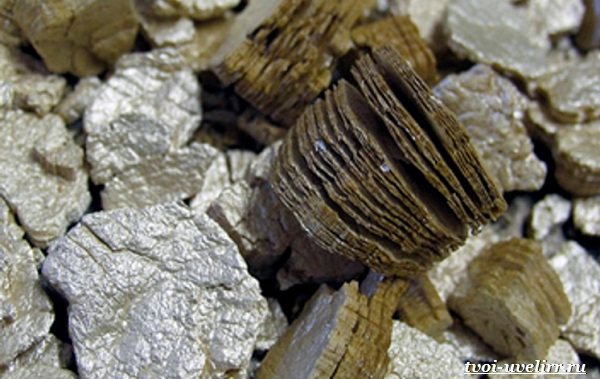

The formula that describes the chemical composition of this mineral looks like this: (Mg + 2, Fe + 2, Fe + 3) 3 [(Al, Si) 4O10] · (OH) 2 · 4H2O.
But it should be noted that vermiculite rarely meets this formula, often it contains impurities that must also be taken into account.
An interesting fact is that vermiculite can change its structure when heated and turn into expanded vermiculite... This happens at 900 degrees Celsius, at which time the vermiculite plates become like columns, which are vaguely similar to the very worms that served as the basis for the name of this mineral.
When heated, vermiculite swells up strongly, it is enough to put this mineral in a fire, and then these pieces of vermiculite will turn into golden, almost weightless balls. However, in this form, vermiculite is unstable, with any, even very light, touch or from a gust of wind, the balls crumble into separate tiny flakes that look like dust.
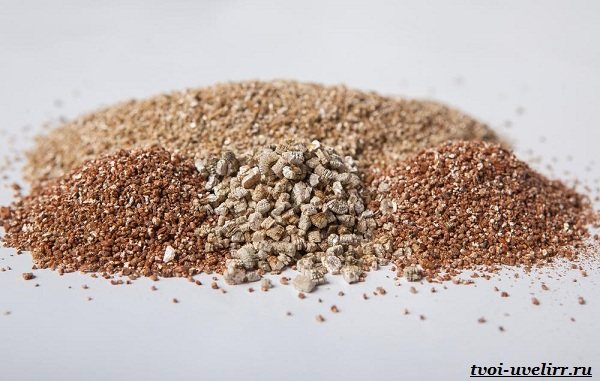

Expanded vermiculite becomes when exposed to temperature
During the process of converting from one state of vermiculite to another, a characteristic crackling sound is heard. Many shamans and magicians use these quality of vermiculite.
If you look at other characteristics of this mineral, you get the following picture: according to the mineralogical scale, the density of vermiculite is estimated at 1-1.5 units; density of vermiculite is 2.4-2.7 g / cm3, but in expanded vermiculite this figure is much lower and is 0.065-0.130 g / cm3.
When heated and transformed into an expanded state, vermiculite can increase in volume up to 25 times. It should be noted that vermiculite belongs to the class of natural minerals that are biologically stable. This means that vermiculite does not decompose and does not undergo the decay process under the influence of various microorganisms.
In addition, vermiculite is not a favorable habitat for insects and rodents. Alkalis and acids do not have any effect on vermiculite, therefore this mineral is called chemically inert.


Other features of vermiculite
What is vermiculite? A similar question may arise for many newcomers to the field of crop production who first hear such a definition. Experienced people are aware of the benefits of this mineral and know some of its features, which can be considered as advantages:
- The material does not rot - it is indifferent to the effects of various pests, including fungi and microbes.
- These durable stones can be used for several years.
- Thanks to vermiculite, the soil becomes softer and more airy.
- This material contains chemical elements necessary for many plants.
- Vermiculite can be used for composting.
- It is worth adding vermiculite to the potting soil, and the flowers can already be watered less often than usual.
As for the term of use of vermiculite, this is quite an impressive figure - up to 10 years.


However, the old material should not be thrown away - it is enough to rinse it well, dry it, and then ignite it in the oven or in a frying pan. It can now be reused.
Physicochemical characteristics of vermiculite
In nature, this mineral has a discreet but noble color. In vermiculite placers, you can find shades of silver, brown, gold and black.
Its composition is no less rich. It contains many useful trace elements. Vermiculite does not contain toxic components, therefore it is recognized as an environmentally friendly substance.
Due to the presence of a number of useful properties, it is deservedly popular with plant breeders.The mineral used to improve the soil is practically eternal.
- It does not rot or decompose. He is not afraid of natural and biological factors of influence.
- Microorganisms, insects, rodents and other small animals do not like it, which means that they will not spoil it.
- The mineral has truly fantastic moisture-absorbing properties. Only 100 g of this highly porous substance can absorb 400 ml of water.
- At the same time, he himself absorbs very little moisture.
- Another amazing property of the mineral that cannot be ignored: when heated to 1000 degrees, it increases 25 times.
All of its beneficial properties in the aggregate came in handy in the field of agriculture. The mineral is readily used by gardeners and flower growers.
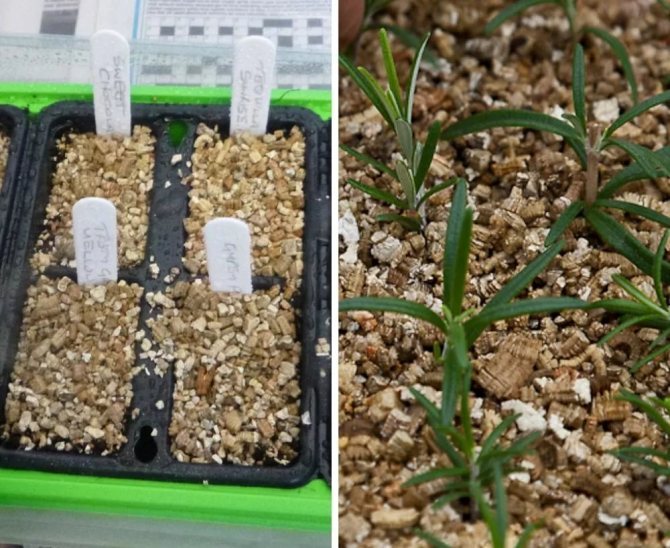

Vermiculite properties
- Does not rot or decompose
- Not affected by rodents and insects
- Ecologicaly clean
- Weakly hygroscopic
- High heat and sound insulation
- Does not react to acids and alkalis
- High coefficient of water absorption
- Temperature resistant
- Improves soil composition
A number of disadvantages
It is important not only to know how to apply vermiculite to plants, but also to understand that everything has both pros and cons. And despite the obvious advantages, the material also has a number of disadvantages. On the one hand, the presence of a large number of chemical elements that are so necessary for plants is, of course, a plus. However, the fact that they are in an indigestible form is, without a doubt, already a minus. For this reason, vermiculite should not be considered a complete fertilizer.
Failure to comply with the dosage of vermiculite leads to a change in the acidity of the soil to the alkaline side. In addition, this can happen due to watering the plants with tap water, which is quite harsh.
Vermiculite for plants: how to apply
By absorbing moisture and gradually giving it to the plant, vermiculite will not only reduce watering, but also, when used as a drainage, will protect it from waterlogging by absorbing excess moisture.
The soil prepared with the addition of vermiculite is light and loose. Good air and water permeability. What is especially valuable, saturated with water, vermiculite retains the same lightness and friability. Prized in construction for its thermal insulation properties, it performs the same function in a flower pot, protecting the roots of plants from high and low temperatures. Thanks to the addition of vermiculite, the soil in the pot practically does not sour, and a hard crust does not form on the surface.
As I mentioned above, vermiculite is excellent drainage. It is especially good for planting - transplanting indoor plants, in small pots, when the use of traditional expanded clay is difficult due to its large size. And in terms of its ability to absorb, and then release moisture, vermiculite surpasses all other materials for drainage.
But it is used not only as a component of the soil mixture. For example, it is used as a medium for germinating seeds or rooting cuttings. When rooting cuttings in even the lightest peat mixture, there is always a danger of their rotting due to the presence of various microorganisms in the mixture. Vermiculite is devoid of this drawback, it is practically sterile.
Vermiculite is also the most suitable mulch for indoor flowers. If you scatter a small amount of it over the surface of the earth, it will significantly retain moisture and prevent the soil from drying out quickly.
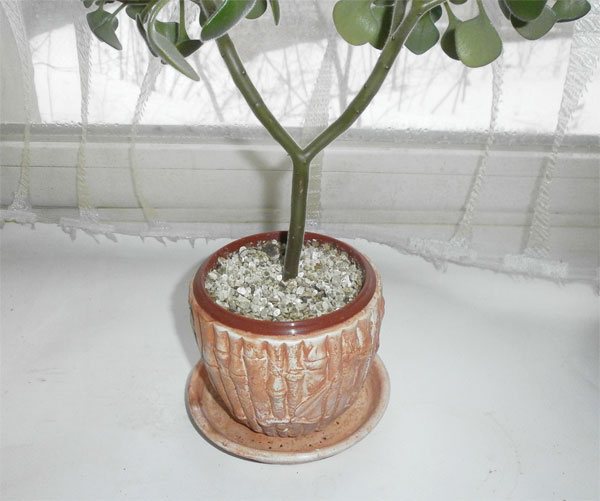

The lightness and flowability of vermiculite, combined with thermal insulation properties, make it an excellent material for storing tubers and flower bulbs dug up for the winter.
Of course, all of these properties make it one of the most used fillers for growing plants in hydroponics.
Application area
It is worth noting that there are materials that are unknown to the mass consumer, but at the same time have a lot of advantages and have a wide range of applications.And vermiculite is just one of those. This material is of natural origin - it is a product of volcanic activity. Humanity has adapted it to its needs for a long time.
Vermiculite is known to professional builders as a quality material. Experienced gardeners and gardeners also know about it. But how is vermiculite used?
How to use vermiculite in the garden, in the garden, at home. Scope of its application
Over the past decades, vermiculite has firmly established itself in crop production. Agricultural specialists and hobby growers are willing to use this mineral for mulching, drainage, improving the general condition of the soil, germinating seeds and growing seedlings.
In the garden.
Modest in appearance, vermiculite can be called the best business partner for gardeners. The range of its application in horticultural business is wide and multifaceted.
- Gardeners often use it to improve soil quality. For this purpose, the mineral is introduced into the soil, and it becomes looser and more moisture-consuming. When planting shrubs and seedlings, it is difficult to find an analogue of vermiculite. It significantly accelerates the rooting and development of plants.
- A solution of preparations of the “Fine” and “Medium” brands will strengthen the resistance of seedlings to diseases and soon young trees will delight gardeners with their healthy, cheerful appearance and high yield.
- Experienced gardeners mulch the ground around tree trunks with a mixture of the brands Large, Fine and Medium. The amount of substrate from 6 to 10 liters can be processed one square meter, and this will reliably protect the soil from drying out, regulate the water-air regime, provide protection from weeds, and prevent lying fruits from decay.


In the garden.
Vermiculite provides invaluable assistance to gardeners. Its applications in gardening work are multifaceted. Used correctly early in the season, this mineral will greatly increase the chances of a good harvest.
- To increase the fertility of the garden soil, the mineral is mixed with peat or with ordinary soil. It gives compost looseness and porosity.
- Vermiculite is also used for germinating seeds, cuttings, growing fruit and vegetable crops in the garden and greenhouses, mulching.
- When planting potatoes, gardeners add 10-15 grams (0.5 tablespoon) of vermiculite granules to each hole. This measure makes it possible to get a high yield of this crop. At the same time, the plant becomes more resistant to root rot and increases yield by 15-17%.
- And even when the crop is harvested, vermiculite will help extend its shelf life. Lined in wooden boxes in rows of potatoes, onions, garlic, carrots, beets, sprinkle with vermiculite granules. Vegetables during storage emit gas exchange products. Vermiculite, due to its low hygroscopicity, adsorbs the secretions formed by the fruits, thereby preventing them from decay.
- In the future, the spent vermiculite can be used to produce compost or mulch the soil with it. If you ignite it, then it will again be suitable for storing fruits.
At home.
Experienced growers achieve significant success in the preparation of soil for indoor plants, skillfully using the appropriate brand of preparation containing vermiculite.
- For indoor flowers with a small root system, Fine brands are well suited.
- If the roots of indoor plants are well developed, it is better to use a mixture of "Fine" and "Medium" for them.
- For large plants growing in rooms and planted in tubs, mixes "Medium" and "Large" are provided in equal proportions.
Vermiculite is a good means of cutting flowers. Micron, a vermiculite-based substrate, helps cuttings root better. All of these preparations contain many minerals necessary for the development of indoor plants.
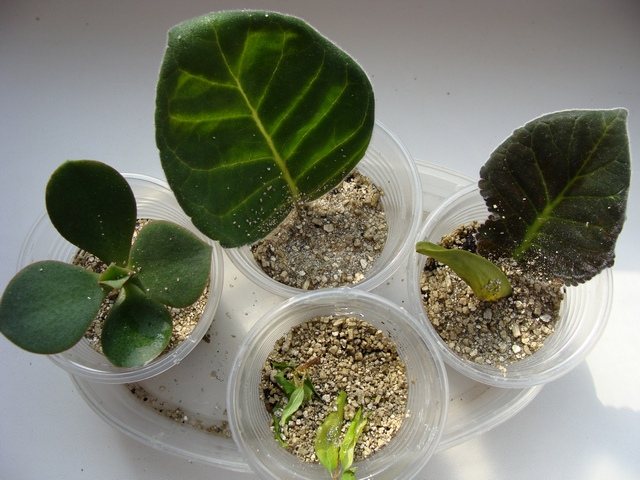

Due to the unique properties of the natural mineral vermiculite, they endow indoor plants with vital energy, stimulate their growth, regulate water-air exchange, and protect the roots from mold.
The soil in pots with indoor plants, enriched with vermiculite, always remains loose, which allows the root system to develop well. In the presence of this mineral, the temperature of the earthen ball is regulated. Thus, the soil in a pot on a windowsill is protected from overheating in summer and from hypothermia in winter.
Vermiculite retains moisture well, so plants do not need frequent watering.
Hydroponics
This term refers to the cultivation of plants and garden crops without the use of soil. On the one hand, this allows you to get rid of many problems. There is no stagnation of moisture, moreover, contact with harmful microorganisms and insects is completely excluded. But at the same time, this technology is complex. In addition, not every plant will be able to take root in such conditions.


The use of vermiculite in this case will be the best choice. The material will serve as a good alternative to soil. Small stones will strengthen the root system of plants. In addition, all the benefits that have already been discussed will be useful.
How does the soil change after adding vermiculite


Let us summarize and summarize in one list exactly how vermiculite affects the quality of the soil:
- The soil changes for the better, and regardless of what kind of soil - clay or sandy, indoor plant or garden plant growing in the beds
- The most favorable conditions for air enrichment are created
- The root system is maximally protected
- The acidity of the soil is normalized, and the salt content is also reduced
- Fertilizers are better accepted by the plant, both in horticulture and in plant growing
Dive seedlings
We already know about vermiculite (what kind of mineral it is), now it's worth getting to know one more option for its use. In this case, it is worth using a soil mixture of the following composition: 1 part of vermiculite with a fraction of 1-2 mm for 2-3 parts of soil. All must be mixed thoroughly, and then distributed into cups.
When the time comes for planting grown plants in open ground, it is worth adding vermiculite in the amount of 2-3 tablespoons (fraction 2-4 mm) to each open hole. This will maintain the required moisture level near the roots, which, in turn, greatly facilitates the care of the planted crop.
Chemical composition
The chemical composition is not constant depending on the content of molecular water.
Magnesium oxide (MgO) 14-23%, iron oxide (FeO) 1-3%, iron oxide (Fe2Os) 5-17%, aluminum oxide (А12O3) 10-13%, silicon dioxide (SiO2) 37-42%, water (H2O) 8-18%. In addition, K2O is present - up to 5%, in some varieties of NiO - up to 11%.
Crystallographic characteristic
Syngonia Monoclinic.
Symmetry class... Vermiculite is probably of the prismatic type - 2 / t. in. from. Cc, a0 = 5.33 A, b0 = 9.18 A, c0 = 28.90 A, p = 97 °. Axis ratio. - 0.6: 1: ~ 3.2; {3 = 97 °.
Crystal structure layered.
Germinating seeds
Due to the ability to accumulate moisture, and in a fairly large amount, the mineral allows you to create an optimal moisture level, which contributes to the formation of strong and healthy seedlings. What is vermiculite? This is a humid environment that will remain unchanged for a long time, which is beneficial for the seedlings that have not yet matured.
For these purposes, it is better to use expanded vermiculite with a fraction of 1 mm. Everything should be packaged in plastic bags and placed in a warm place for seeds to germinate. And when the sprouts are already visible, they are sown in a container where the soil mixture is preliminarily placed (1 part of vermiculite with a fraction of 2 mm per 2 parts of soil).


If you prepare the mixture correctly, the seedlings will sprout faster and the root system will be reliably protected from rot (black leg).
What is agrovermiculitis
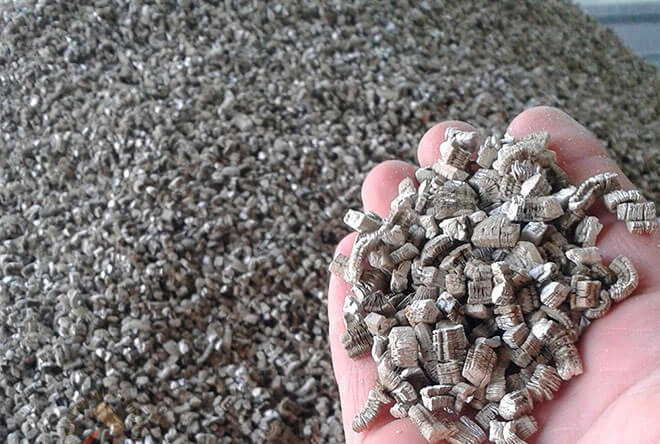

Agrovermiculite is a material obtained as a result of secondary firing of ordinary vermiculite with a size from one to ten mm in diameter in a fraction. It is worth saying that minerals ranging in size from 3 to 5 mm are used for breeding plants at home, that is, it is agrovermiculite.
If the porous material was needed in the country or for landscape work, it is recommended to use a larger diameter of vermiculite.
The described mineral contains useful trace elements and materials:
Benefits for indoor plants
Now there should be no doubts about vermiculite. We already know what kind of mineral it is, and its benefits for plants are also known. At the same time, the scope of this material is not limited only to agricultural crops.
In home floriculture, there is also a use for it:
- The use of vermiculite helps to loosen the soil mixture. At the same time, the content of agrovermiculite can be up to 30%, which will significantly affect the characteristics of the soil, and for the better. It will become porous, loose, without lumps and seals.
- Vermiculite is also good as a drainage system. To do this, lay out the bottom of the pot with coarse material.
- Mulching. The use of vermiculite in pots avoids colonization of the soil with sciarides, mealybugs and other soil pests.
- Scenery. Vermiculite is able to attract attention due to its shade and crumbly structure. In this regard, the material is perfect for decorative powdering around plant stems, as well as in pots and pots.
And it should be noted that in indoor floriculture the use of vermiculite is gaining more and more popularity for obvious reasons.
Perlite and vermiculite - what's the difference?
Despite the lightness, flowability of these two materials differ in appearance: perlite is white, dusty, vermiculite is dark in color. There are no nutrients in perlite, and vermiculite contains aluminum, calcium, magnesium, iron, silicon, potassium (in bound form).
Vermiculite, unlike perlite, can absorb beneficial compounds from the soil, and then gradually release them. It is also very water-absorbing compared to perlite.
Perlite is an excellent conductor of moisture, but a poor retainer, while vermiculite, on the contrary, retains it very effectively. Vermiculite has an elastic structure, and perlite collapses and becomes dust with active physical exposure.
Perlite or vermiculite - which is better for plants? This question cannot be answered unequivocally, it cannot be said which material is better, since everything depends on the plant itself, its needs. For example, for some flowers (the same indoor violets or gloxinia), wick watering is sometimes used. In this case, perlite is ideal, which is used to dilute the substrate in the pot - it contributes to an even distribution of moisture over the soil, and the soil itself dries faster. Vermiculite, on the other hand, will be more appropriate with the usual method of irrigation - the soil will stay moist longer due to its moisture-accumulating properties.
It is impossible to determine which is better than perlite or vermiculite, since this or that additive is equally suitable for each type of plant. These two materials are equally good, have similar qualities, but still slightly differ in "technical" characteristics.
They complement each other perfectly, improve the soil. To get the optimal soil mixture, growers take 15% of each material, mix them, while the total additives (relative to the rest of the soil mixture) should be 30%. A mixture of peat, perlite and vermiculite is most commonly used for growing indoor plants.Vermiculite is suitable for delicate, capricious representatives with a vulnerable root system, perlite is more suitable for powerful plants, cacti or succulents.
New opportunities for growing plants are constantly appearing on the market - care products, all kinds of additives. Almost any product can be purchased today. If you are not yet familiar with these materials, pay attention to them. Vermiculite or perlite for plants will save you time in caring for them, eliminate many problems (fungi, mold), improve the composition of the soil, and help keep the planting material in good condition.
Rules for the use of vermiculite
Before using vermiculite for indoor plants, it must be rinsed well. This material is soft and quite fragile. Otherwise, large amounts of dust cannot be avoided, which will enter the lungs, eyes and nose.
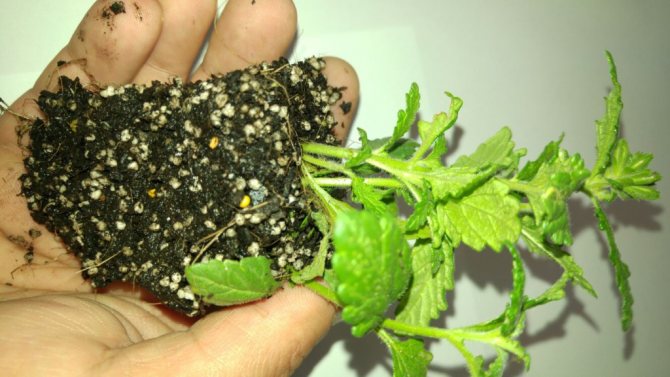

In extreme cases, you can use appropriate protective equipment, but suitable goggles and a respirator are not always at hand. But in fact, why come up with unnecessary troubles, because it is much easier and faster to just rinse the material, and it will become absolutely safe. In addition, you can wash off all the dirt from it.
Since vermiculite is able to maintain soil moisture (especially when there is a lot of it), this fact should not be forgotten when watering. They should be regular, but rare at the same time. We already know what frequent watering can threaten.
Water quality should not be ignored. Pure vermiculite for plants has neutral acidity (pH). Using hard water for irrigation leads to alkalization of the material. And this is no less dangerous than acidification. Neither alkaline nor acidic environment is good for plants.
For this reason, hard water must be softened beforehand. In an extreme case, boiled, settled water is suitable.
Perlite - what is it?
It is a volcanic rock formed by hydration. Obsidian hydroxide is perlite, initially it can have a different shade (brown, black or even green). After special processing, the material becomes white, porous, it is crushed, used as an additive to potting mixes. Perlite promotes an even distribution of moisture in the soil, is an ideal component for hydroponic growing of plants, and loosens the soil well.
Perlite - what is it? It is a sterile substance without impurities, resembling sand in its properties (the main component is silicon dioxide). With its help, you can root cuttings, grow seedlings, use it as an additive to various substrates. It improves the aeration of the soil, optimizes its drainage and water-holding properties.
Perlite is very dusty, so when working with it, be sure to wear a protective mask.
When inhaled, microparticles of glass dust enter the body, but subsequently not displayed from it - remember this.
Agro perlite, photo:
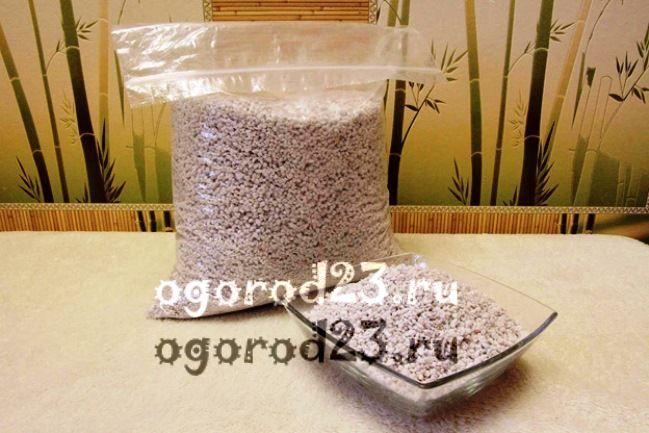

Like vermiculite, this material improves the soil structure, retains moisture, and prevents the formation of a crust on the upper layer of the soil. The addition of perlite can increase the aeration of heavy soils, as well as increase the water-holding qualities of light soils. It reduces the level of soil acidity, slows down its salinization, and prevents waterlogging during prolonged rains.
If suddenly you overdo it with fertilizers, then perlite will absorb them, and then gradually give them to the soil.
After three or four years, the perlite granules are destroyed, digging, loosening only contributes to this.
Perlite for plants - how to apply? Its presence in the soil is simply irreplaceable for flowers with a weak root system, like sand, perlite loosens the earth, making it light. Strong plants with strong roots also need it, because stagnant moisture can lead to rotting.
For rooting shoots, germinating seedlings, you can use clean material, but mixing with sphagnum or peat also gives excellent results. Summarizing all of the above, we can safely say that these two additives are combined with each other, ideally complement each other's qualities, and have the same effect on soil and plants.
Arugula in perlite, photo:
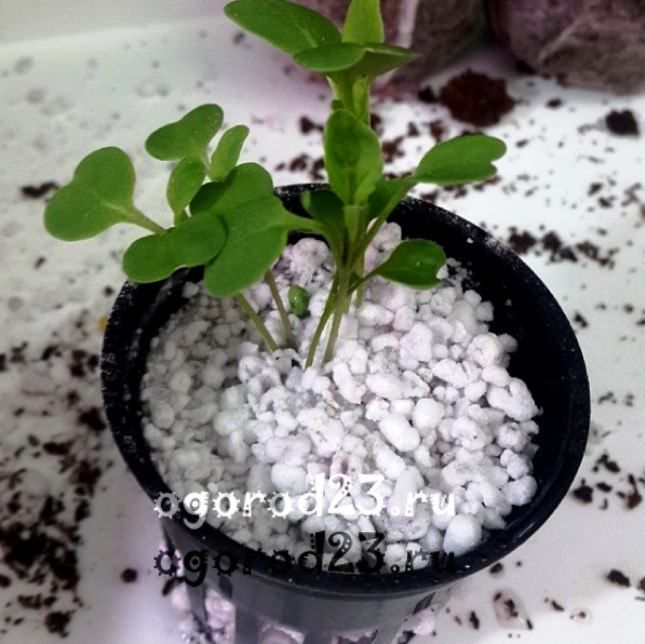

The scope of application of both additives:
- Can be used as drainage (coarse fraction).
- They are used to cover the top layer of soil - they prevent mold and crust formation.
- Bulbs, tubers of flowers are poured, they are buried for comfortable storage - this is reliable thermal insulation, protection from decay.
- Wet vermiculite or perlite is an ideal substance for germinating seeds, for the formation of roots in cut shoots.
- A mixture of both materials (equal proportions) is used in hydroponics.
- The pH level of both additives is neutral - this should be taken into account when preparing potting mixes for plants with specific soil requirements.
The combination of these two materials creates an optimal environment for the development, growth of your plants, both in pure form and in soil mixtures.
Vermiculite - gladioli shoots, photo:
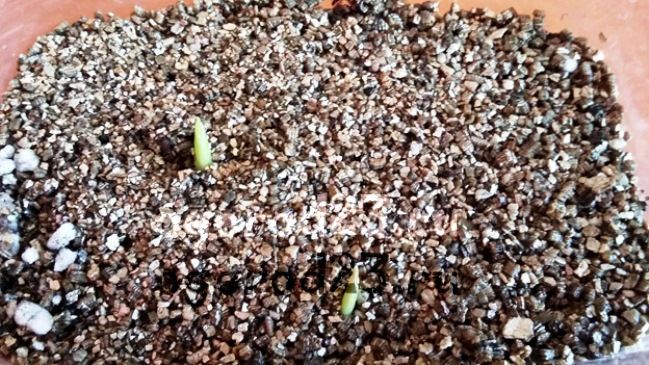

Vermiculite - cucumber shoots, photo:
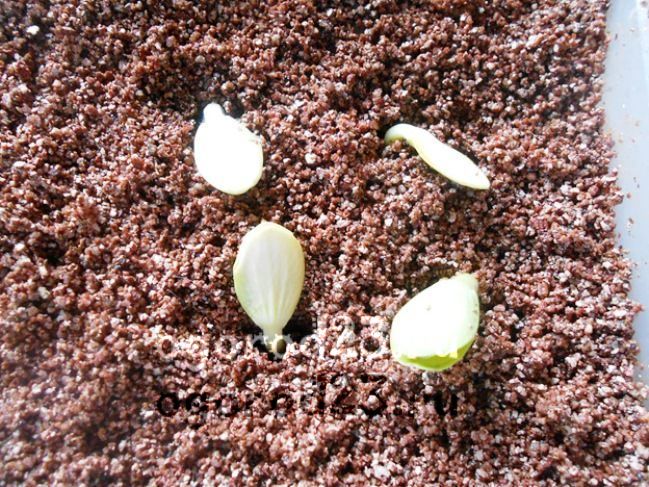

Vermiculite realization
Vermiculite comes to retail in small packages from 250 ml to 3 liters. The following brands represent the Russian market:
- Fasco.
- Hera.
- Eco Garden.
- "Gardens of Auriki".
- Peter Peat.
- Florizel.
The average cost of 1 liter varies from 30 to 40 rubles.
At the same time, vermiculite can be purchased in large volumes: 10-50 liters. To do this, it is worth contacting one of the large garden or construction centers (yes, this is also a good building material). In this case, the cost of 1 liter will also reach 30 rubles.
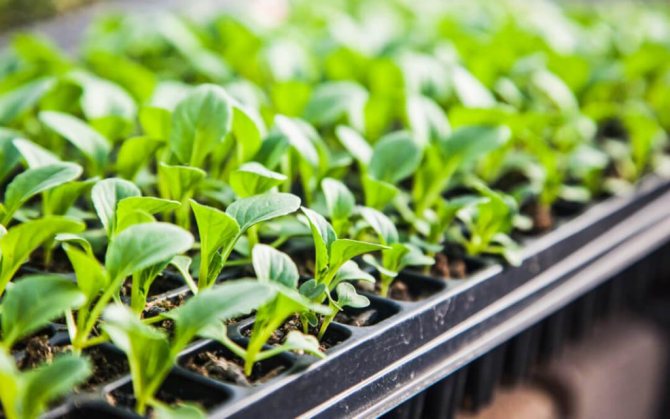

As for the producers of vermiculite, the bulk of this concentrate is made in the USA and South Africa, and the volumes have only increased recently. Tellingly, the raw material base of vermiculite abroad is significantly limited on a territorial basis. Despite this, the use of the mineral is still cost-effective.
The implementation of wholesale deliveries is carried out by various online stores, which include, "SibEcoVer", "Lotos". The cost of 1 kg will be 25-35 rubles.
Other properties
The most remarkable property of vermiculite is its ability, when calcined (in the temperature range 900–1000 ° C), to increase its volume unusually sharply (by 15–25 times). The essence of the phenomenon lies in the fact that under the pressure of molecular water turning into steam, separation and rapid swelling of individual individuals along the c axis occurs, and moreover, so significant that worm-shaped columns or threads (depending on the grain size in the cleavage plane) of golden or silver color are formed with transverse division into the finest scales. The formation of a huge number of the smallest air gaps in individual individuals leads to a very low volumetric weight (0.6-0.9). Fired masses of vermiculite float freely on the water. This is associated with the high thermal insulation properties of fired vermiculite. Thermal conductivity coefficient l = 0.04–0.05 kcal / m / h ° С (y - asbestos 0.15–0.40).
Diagnostic signs
Similar minerals. Biotite, phlogopite, end product of biotite weathering (bauerite), chlorite.
Outwardly, vermiculite is similar to weathered biotite or chlorite. The most indicative feature is the behavior of its behavior under the belly tube with a pronounced swelling and the formation of long worm-like curved threads or columns.
Associated minerals. Biotite, phlogopite, minerals of the serpentine group: chrysotile, antigorite, chlorite, magnesite.
Testimonials
As for the opinions about such a useful and necessary mineral as vermiculite, they are mostly positive. Someone came across it for the first time many years ago and was satisfied with the result.Many gardeners note that before using this fertilizer, they had never had such beautiful and blooming seedlings. The moisture in the soil did indeed persist for quite a long time.
As the reviews on vermiculite show, many were convinced from personal experience how much vermiculite is dusty. Therefore, it is better to rinse it before using it to minimize all risks.
Where is vermiculite used?
We recommend reading our other articles
- Growth stimulator Heteroauxin
- Fertilizer Azofosk
- Insecticide Vertimec
- Pruning grapes in autumn
After extracting vermiculite, it is sent to factories, where it is divided into fractions, heated and expanded vermiculite is obtained in the required quantities. But what is this mineral for? The range of applications for this substance is quite wide:
- agricultural sector;
- building;
- aircraft construction;
- car manufacturing;
- energy;
- light industry, etc.
Interesting!
In England and the USA, vermiculite is often called the yield mineral. And in Japan, it is a medicinal mineral.
As you can see, the use of the mineral is very diverse. Due to its qualities, it is in demand today. It is mined mainly in America and Ukraine. South Africa, Russia, Uzbekistan, Uganda, India and the Australian continent.
Place of Birth
For the first time, vermiculite was discovered at the beginning of the 19th century; it received industrial application only 100 years later. For the development of several technologies for its application, Yakub Akhtyamov received in 1979 the prize of the Council of Ministers of the USSR for "Research, development of technology and introduction into the national economy of vermiculite and products based on it."
Deposits on the Kola Peninsula (Murmansk Oblast) and in the Urals near the town of Kyshtym (Chelyabinsk Oblast), in the Krasnoyarsk Territory - the Tatarskoe field, in the Irkutsk Oblast - the upper reaches of the Uluntui Valley and the town of Slyudyanka. Abroad - in Western Australia, USA (Montana, Colorado, Wyoming, North Carolina, Georgia), Uganda, Ukraine, South Africa, Kazakhstan (Kulantau field in South Kazakhstan oblast), Uzbekistan (Karakalpakia).
Application in horticulture
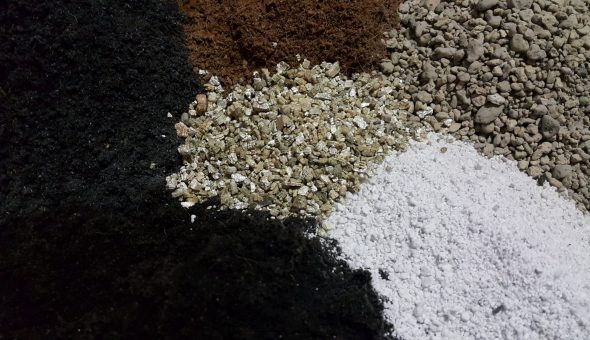

Widely used in horticulture
Vermiculite is widely used in horticulture. The mineral is included in many agro-mixtures sold through stores in 50 kg bags, and is also sold separately, and is quite inexpensive. On the basis of vermiculite, you can make a mixture with your own hands by adding it in the required proportion. The fossil can perfectly replace expanded clay used as drainage.
Although the free-flowing mixture contains many useful substances, they are in a state that is difficult to access for the root system, so fertilizer will have to be applied. The main advantage of the mineral is the ability to accumulate active ions from dressings in the interfractional space. The shelf life of the mineral is practically unlimited, everything will depend on the safety of the fractions.
If you will be using a lot of vermiculite in your garden, wear a gauze bandage. The mineral is lightweight and quite fragile, therefore, when working with it, a large amount of dust is formed. If vermiculite is used for home flowers for the first time, it is better to wash it first. When reused, the product must undergo a decontamination procedure by calcining. It is sent to the oven for 20 minutes, kept at 100 ℃.


